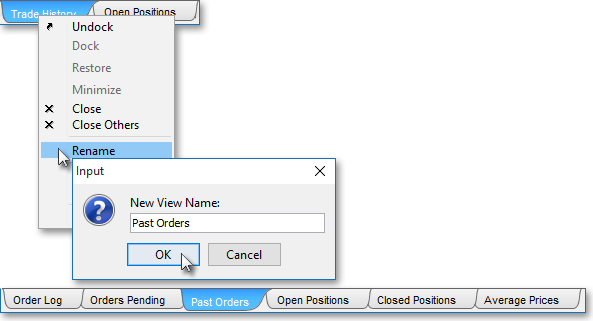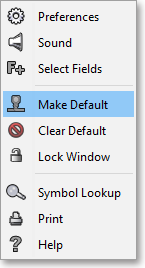Order Log Tab
The "Order Log" tab in Neovest's Account+ window is designed to monitor the real-time status of your individual orders and maintain a complete record of all orders sent from your account. In addition, Neovest lets you track and cancel individual orders that are displayed in an Order Log tab in an Account+ window.
Neovest's Order Log tab contains several default display fields (i.e., "Time," "Buy/Sell," "Original Quantity," "Symbol," "Order Type," etc.) that provide you with essential information regarding each of your orders.
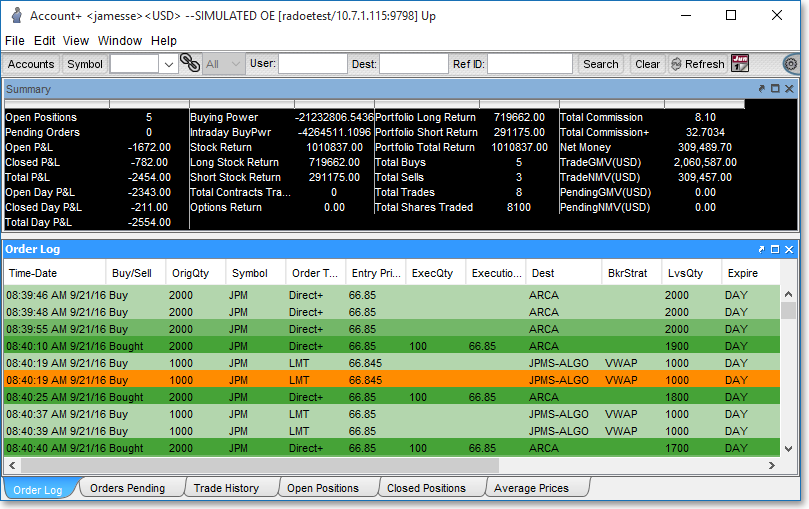
The following table provides descriptions of the default display fields contained in the Order Log tab in Neovest's Account+ window:
| Feature: | Description: |
| Time-Date | Shows the time and date of the order message (i.e., "Sent," "Pending," "Partial," "Canceled," etc.). |
| Buy/Sell | Shows a "Buy," "Buy Cover," "Bought," "Sell," "Sell Short," "Sold," or "Sold Short" for each order. |
| Original Quantity | Shows the original number of shares entered for each order. |
| Symbol | Shows the ticker symbol entered for each order. |
| Order Type | Shows the order type selected for each order. Neovest lets you select one of eight different order types: "MKT," "LMT," "LOB," "STOP," "SLMT," "MOO," "MOC," and "PEG." For descriptions of the order types that Neovest supports, refer to the "Stock Order Ticket Descriptions" section in the "Orders" chapter in Neovest's Help documentation. |
| Entry Price | Shows the entry price of the entered symbol for each order. |
| Stop Price | Shows the price that must be reached or bettered in order for an automatic market or limit order to be generated. A Stop Price should be entered below the current price if the order is a sell order and above the current price if the order is a buy order. Stop Price sell orders are generally used to limit potential losses on long stock positions in falling markets, and Stop Price buy orders are generally used to protect against an upside risk if a stock has been shorted. "STOP" or "SLMT" must be selected as the order type and a "Stop Price" value must be entered during the setup process of an order for this display field to show a value. For descriptions of the order types that Neovest supports, refer to the "Stock Order Ticket Descriptions" section in the "Orders" chapter in Neovest's Help documentation. |
| Destination | Shows the destination selected for each order. For information on the destinations that Neovest currently supports, refer to the "Order Entry Destinations" section in the "Orders" chapter in Neovest's Help documentation. |
| Parameters | Shows the parameters of the broker strategy associated with each order. Keep in mind that the time values shown are set in local time, based on your computer's system time. Note: If you hover over the data in this field with your mouse cursor, the selected parameter data will appear in a carriage return-delimited list, rather than one long comma-delimited string. |
| Execution
Price |
Shows the executed price of the entered symbol for each order. |
| Executed Quantity | Shows the number of shares executed for each order. |
| Leaves Quantity | Shows the number of shares remaining for each order if only a portion of the original number of entered shares has been executed. |
| Expire | Shows the order expiration type selected for each order. Neovest lets you select one of 13 different order expiration types: "Day," "Day+," "GTC," "OPG," "FOK," "IOC," "GTD," "GTW," "GTM," "GTY," "GTX," "GTT," and "NOW." For complete descriptions of the order expiration types that Neovest supports, refer to the "Stock OrderTicket Descriptions" section in the "Orders" chapter in Neovest's Help documentation. |
| Status | Shows the current status (i.e., "Sent," "Acknowledged," "Pending," "Executed," etc.) of each order. To view the complete list of statuses that may be displayed in the "Status" field, refer to the "General Tab" section for the "Account Preferences" section in the "Account" chapter of Neovest's Help documentation. |
| Order ID | Shows the order ID that Neovest has assigned to each order. |
| Reference ID | Shows the reference ID that you have assigned to each order. You may utilize reference IDs as identifiers to distinguish individual orders after they are sent from a Neovest Order Entry window and appear in a Neovest Account+ window. For information regarding how you may set reference IDs for individual orders, refer to the "Ref. IDs Tab" section in the "Order Entry Preferences" section in the "Orders" chapter in Neovest's Help documentation. |
| Account | Shows the account selected for each order. |
| User Name | Shows the user name of the person who sent each order. |
| Info | Shows messages generated by Neovest's Order Entry server that are pertinent to each order. For example, if you attempted to cancel a certain order and the cancel was not successful, this field would provide that information. |
By using the preceding table as a guide, you may understand the default display fields in the Order Log tab in Neovest's Account+ window.
The following table provides descriptions of the non-default display fields you may choose to add to the Order Log tab in Neovest's Account+ window by clicking with the right mouse button on an existing display field and selecting Show Fields from the menu that appears:
| Feature: | Description: |
| Account Type | Shows whether you selected "Cash," "Margin," or "Short" for each order. |
| AcctCompany | Shows the name of the company where the trading account resides. |
| AcctShort | Shows the name of the company where the short trading account resides. |
| Call/Put | Shows whether each option order is a "Call" or a "Put." |
| Commission | Shows the commission charge for each order. |
| Currency | Shows the currency you specified for each order. |
| CUSIP ID | Shows the proprietary symbology identifier used by CUSIP (Committee on Uniform Security Identification Procedures) to identify the security associated with each order. |
| Discr. Offset (Discretionary Offset) | Shows the default Discretionary Offset value you specified for each order. This value is designed to allow an order to be filled outside the specified Limit Price. For example, if you enter a Discretionary Offset of ".10" for an order with a Limit Price of $50, then the order will display at $50, but the order is given discretion to fill up to $50.10. |
| Discr. Qty. (Discretionary Quantity) | Shows the Discretionary Quantity value you specified for each order. This value is generally used to determine a discretionary quantity in connection with the quantity specified in the "Display" field. This feature may be used differently in conjunction with different types of orders, so for assistance with understanding the Discretionary Quantity feature, refer to the descriptions of the order types that each Neovest supported destination provides in the "Order Entry Destinations" section in the "Orders" chapter in Neovest's Help documentation. |
| Display | Shows the number of shares you specified to be displayed with each order. Specifying a Display number lets you display a lower number of shares for an order than the actual number entered in the "Size" field. This feature is useful when you are sending a large order and you do not wish to influence the price of the entered ticker symbol in either direction. |
| Display Price | Shows the display price offset you specified for each order. This feature is designed to let you offset the Bid, Ask, Last, Mid Price, MMBid (market maker bid), or MMAsk (market maker ask) display price by any positive or negative amount. Note: A display price may be used differently in conjunction with different types of orders, so for assistance with understanding a display price, refer to the descriptions of the order types that each Neovest supported destination provides in the "Order Entry Destinations" section in the "Orders" chapter in Neovest's Help documentation. |
| Ex Destination (Exchange Destination) | Shows the exchange destination you selected for each option order. If you selected a particular exchange destination, then the destination that you selected in the "Destination" field will route your option order to the exchange destination you selected in this field. |
| Exchange | Shows the exchange you selected upon which the symbol of the position is listed. |
| Exp Month (Expiration Month) | Shows the expiration month you selected for each option order. |
| GLA ID | Shows the proprietary symbology identifier used by GL TRADE to identify the security associated with each order. |
| ID Source | Shows the preferred ID source you specified for each order. This feature allows you to determine an appropriate ID source when a particular destination is requiring an alternate security identification. To address the needs of multiple services in the industry that create unique names for symbols, Neovest provides a number of ID sources that you may utilize to prevent potential problems that may arise with complex orders, such as when duplicate symbols appear across different countries' exchanges during international trading. When specifying your preferred ID source, you may choose from the following Neovest-specific and standard identifiers: "CUSIP," "SEDOL," "ISIN," "RIC," and "Exchange Symbol." If you specified "CUSIP" as your preferred ID source, then you are designating that you wish to enter a Committee on Uniform Security Identification Procedures ID number to identify an individual security for an order. If "SEDOL," then you are specifying to use that a Stock Exchange Daily Official List ID number—which is the code used by the London Stock Exchange to identify foreign stocks, especially those that aren't actively traded in the U.S. and that don't have a CUSIP ID number. "ISIN" refers to an International Securities Identifying Number. "RIC" implies a proprietary symbology identifier used by Reuters. And "Exchange Symbol" denotes a proprietary symbology identifier assigned by a specific exchange will be entered. |
| Instruction | Shows the order instruction you specified to send to the selected destination for each order. Note: Each destination supported by Neovest provides its own instructions; therefore, as you select different destinations, the selections in this drop-down menu will change. For information on the instructions that Neovest currently supports, refer to the "Order Entry Destinations" section in the "Orders" chapter of Neovest's Help documentation. |
| ISIN ID | Shows the proprietary symbology identifier used by ISIN (International Securities Identifying Number) to identify the security associated with each order. |
| Min Fill (Minimum Fill) | Shows the minimum fill amount you determined for each order. This feature is designed to let you enter a minimum size requirement before a particular order may be filled. |
| OATS Instruction | Shows the instruction that was given to the broker/dealer at the time the broker/dealer received the request for each trade. This feature is used by broker/dealers who wish to be OATS compliant on orders they receive from their clients. |
| OATS Received Time | Shows the time when the broker/dealer received the request for each trade. This feature is used by broker/dealers who wish to be OATS compliant on orders they receive from their clients. |
| Open/Close | Shows whether each option order was opened or closed. |
| Peg Offset | Shows your specified Peg Offset value, which is designed to cause each order to follow the best bid, offer, or midpoint price (depending on the pegging order type you selected) of the entered symbol. Each time you specify a Peg Offset value, the order will float and display at your specified increment away from the best bid, offer, or midpoint price. |
| Peg Type | Shows the pegging type you selected during the setup process of each order that is used to determine how each order will be displayed in the market. Each Neovest supported destination provides its own unique pegging types. For descriptions of the pegging types that each Neovest supported destination provides, refer to the "Order Entry Destinations" section in the "Orders" chapter in Neovest's Help documentation. |
| Pref MM (Preferred Market Maker) | Shows the Market Maker you specified, which in turn signaled your selected destination as to where each order was to be routed. You must enter the correct MMID of each Market Maker you desire for this feature to function correctly. |
| Preferred Symbol | Shows the symbology you selected for your Neovest system. Neovest's "Symbology" feature lets you specify the symbology identifiers that will be used to request symbol data in Neovest windows. When changing your preferred symbology, you may choose from such Neovest-specific and standard symbology identifiers as "NEOVEST," "ISIN," "CUSIP," "RIC," and "GLA." For information on how you may change your symbology selection, refer to the "Symbology" section in the "Menu" chapter in Neovest's Help documentation. |
| Proactive | Shows whether you granted permission to your selected destination to actively attempt to fill each order with other destinations at the national best bid or offer (NBBO) if it could not fill the order with its book. |
| RIC ID | Shows the proprietary symbology identifier used by Reuters to identify the security associated with each order. |
| Security ID | Shows the unique ID of a particular symbol you entered, based on the ID source you selected, for each order. |
| SEDOL ID | Shows the proprietary symbology identifier used by SEDOL (Stock Exchange Daily Official List) to identify the security associated with each order. |
| Sessions | Shows during which session you wanted each order to be filled. ARCA is currently the only ECN destination that allows this functionality. If ARCA was selected as the destination, then you may have entered "P1" (8-9:30 a.m.), "P2" (regular market hours), or "P3" (4-8 p.m.) as the Session time. |
| Solicited | Shows your specification to your clearing firm whether you marked each order as "solicited" or "unsolicited." If you are unsure of the criteria that your clearing firm uses to determine whether each order is solicited or unsolicited, contact your clearing firm for more information. |
| Strike Price | Shows the strike price you entered for each option order. |
| Ticker ID | Shows the proprietary symbology identifier used by Neovest to identify the security associated with each order. |
| Time | Shows the time of the order message (i.e., "Sent," "Pending," "Partial," "Canceled," etc.). |
| Time-Date (GMT) | Shows the time and date in Greenwich Mean Time of the order message (i.e., "Sent," "Pending," "Partial," "Canceled," etc.). |
| Underlyer | Shows the underlyer you entered for each option order. |
By using the preceding table as a guide, you may understand the non-default display fields you may choose to add to the Order Log tab in Neovest's Account+ window.
Note: Neovest lets you add, remove, and rearrange display fields in the Order Log tab in an Account+ window. For information regarding how you may manipulate the display fields in the Order Log tab, refer to the "Display Fields" sections in the "Account" chapter in Neovest's Help documentation.
Neovest lets you track and cancel individual orders that are displayed in an Order Log tab in an Account+ window. The Track Order and Cancel selections are available on a single menu that you may access by clicking with the right mouse button on an individual order in an Order Log tab.
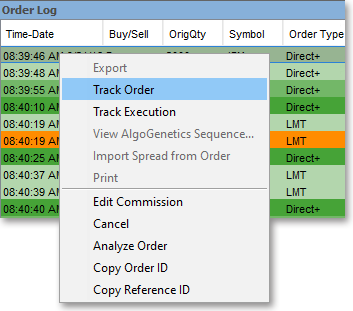
If you access the menu and select Track Order, the "Order Tracking" box will appear and display all relevant information on the order on which you clicked with the right mouse button.
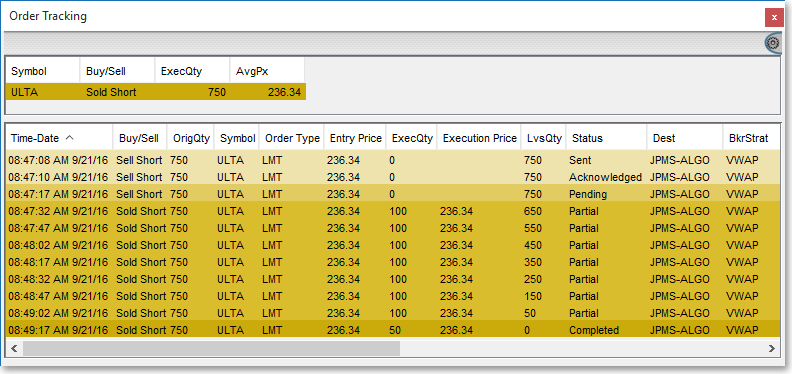
If you access the menu and select Cancel, the "Confirm Cancel" box will appear and will let you click Yes to cancel the order you've selected with a right-click.
Note: If you do not have "Require Verification" checked in the "Security" tab in the "Order Entry Preferences" box, then the "Confirm Cancel" box will not appear when you select Cancel, and the order will cancel immediately without requiring your confirmation.
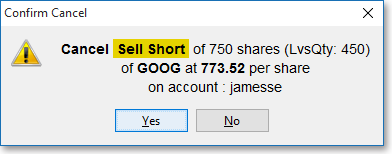
Note (1): Neovest lets you click and hold on an Order Log tab and drag it from an Account+ window. This functionality allows you to arrange an Order Log tab anywhere you wish on your screen. Once you have dragged an Order Log tab from an Account+ window and arranged it on your screen, you may save the configuration in a Neovest layout. Once you close an Account+ window from which you have dragged an Order Log tab, the tab itself will also close.

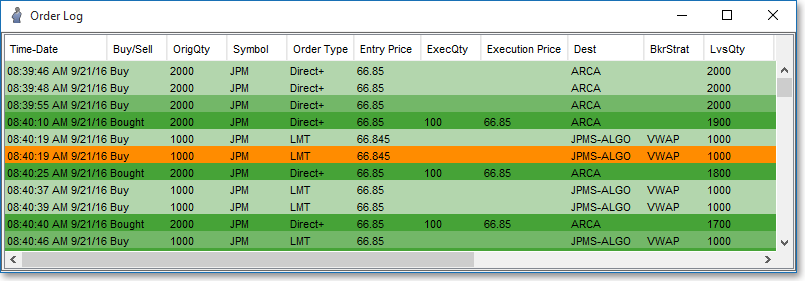
Note (2): Neovest lets you click with the right mouse button on any tab's name in an Account+ window to access a menu that will let you rename the tab. For instance, instead of the title "Orders Pending," you may prefer "Working Orders." Once you click with the right mouse button on an Account+ tab's name and select Rename, the "Input" box will appear. Once you enter the "New View Name" and click OK, be sure to click on the Make All New Account Windows Like This One icon in the Account+ window's toolbar to save the new name as the default.
